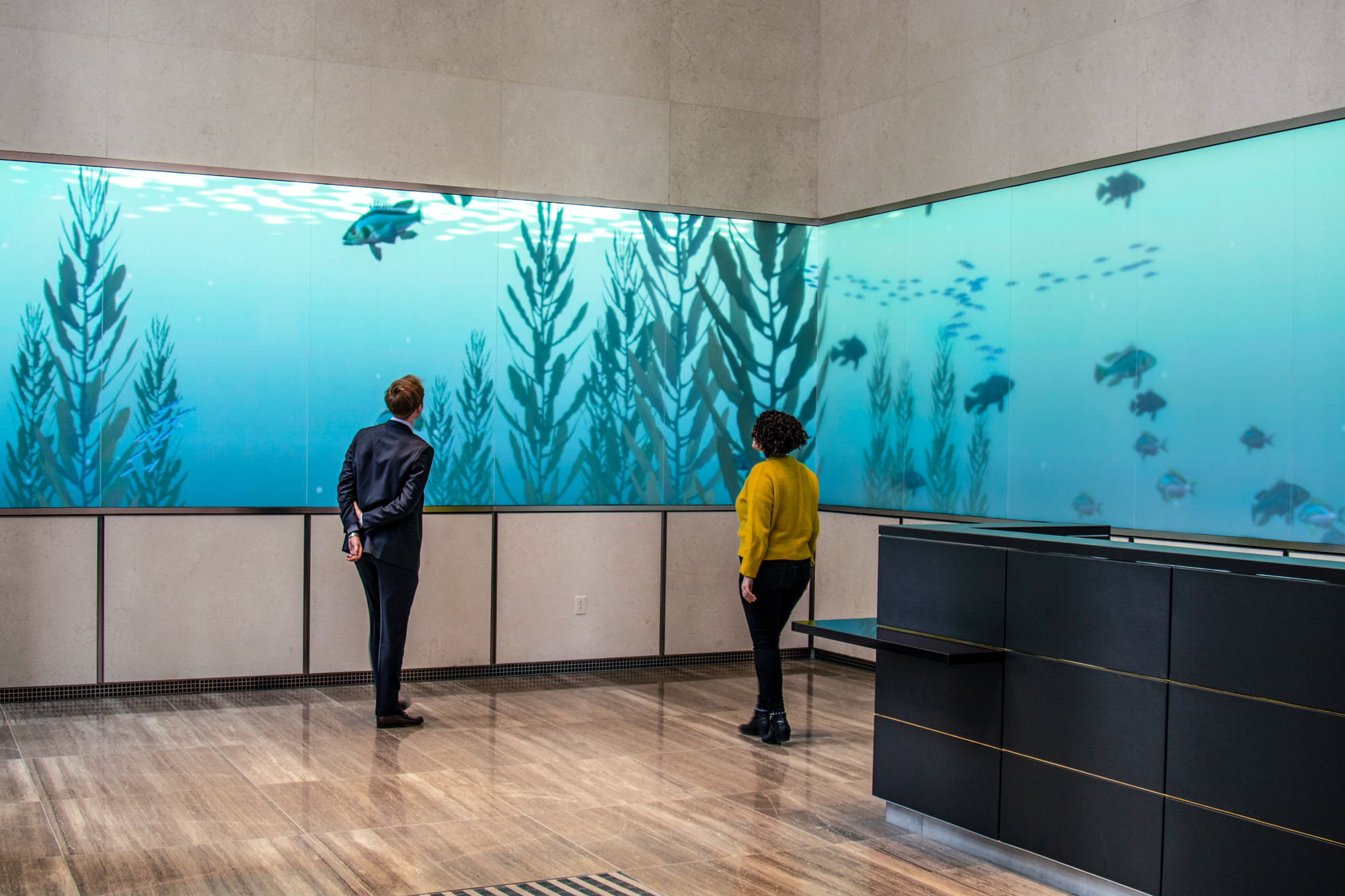Despite a focus on mobility and remote work, corporations are still placing an emphasis on the office environment, according to AVIXA’s MOAR: Corporate report. In fact, AVIXA says, planned capital expenditure among corporate tech managers was approximately $181 billion in the United States in 2018—which translates into nearly $12 billion in AV systems investments given allocations within capex budgets.
And video walls in the office environment are a wise investment for those corporate capex budgets. “LED technology is a status symbol,” said Graham Cooke, market analyst, pro IT–displays, Futuresource Consulting. “It is the newest and most expensive display technology available, and therefore is often utilized by leading corporations to illustrate their wealth and success.”
Popular LED Applications
Every office worker is familiar with the corporate video wall in the lobby. “Large-scale LED displays are installed [in the lobby] as both a status symbol and to provide a ‘wow’ factor to visitors as they enter the building,” said Cooke. “This application was the earliest adopter of narrow pixel pitch LED, as the world’s leading corporations were one of only a few customer groups that could afford the technology’s high price tag. Rivalry between such corporations has proven to be a key purchasing driver, as they compete to have the most striking entrance display.”
[Download the Integration Guide to Video Walls]
NEC Display’s senior product manager Art Marshall cites his company’s lobby as an example. “At our own headquarters Downers Grove, IL, the first thing you see when you enter our space is a breathtaking 165-inch dvLED video wall, setting the tone for the entire visit with bright and colorful imagery. The content of this wall is easily customizable to suit each visitor, and we can even use cameras so that the content reacts to our visitors.”
Now that LED displays have become commonplace in the lobby, they’re quickly moving into the boardroom. According to Emelia Pitlick, marketing director, Neoti LED Video Displays, end users are beginning to upgrade their conference and board room projectors or displays with LED screens for presentations, video calls, and to showcase information.
Using LED video walls for presentations is “perhaps the most exciting application for LED in corporate environments,” said Cooke. “Demand is now being driven by a widening availability of ‘out-of-the-box’ solutions,” so-called as they are sold with a predefined screen size, pixel pitch, and resolution. “These solutions are being sold through the mainstream IT/AV run-rate channel, competing directly with LCD and projection technologies. ‘Out-of-the-box’ LED solutions currently demand a hefty price premium, but as ASPs continue to tumble, it will prove to be a highly disruptive force in the corporate meeting space market,” Cooke added.
Improving the UX in Office Buildings
Corporate branding is a large part of corporate culture today—for employees, partners, and clients alike. Next-gen employees are proud of where they work, and want to feel like they’re part of a team. Visitors want to experience a company’s culture, not just show up for a meeting. It should come as no surprise, then, that LED video walls are being used for branding purposes.
“End users really want to create an immersive brand experience, both internally for employees and also for their clients,” said James Liu, president, Absen. “As LED walls can be made extremely large, when you add high-resolution content, the result is not only impressive, but it creates a memorable experience.”
And that’s not just happening in the lobby. Liu added that many of Absen’s customers are investing in LED technology in areas like employee break rooms to allow “employees at all levels of the company to be integrated into the company culture and [to be] in tune with brand messaging.”
LED versus LCD
Pretty much across the board, manufacturers agree that LED video walls are the preferred screen in corporate environments, and one of the primary reasons they cited was brightness.
“LCDs have a maximum brightness of around 400–600 nits, while the brightness of our indoor products starts at 600–1,000 nits, and we even have semi-indoor products that can reach up to 2,500 nits,” said Absen’s Liu. “By using direct view LED technology in corporate applications, the end user can expect to drastically increase brightness of the screen without spending a lot of money to update lighting in order to accommodate LCD technology.”
“In office buildings, there are often lots of windows and ambient lighting. LCD video walls tend to be dim and show lots of glare in that environment, whereas LEDs provide bright, vibrant displays without reflections,” added Pitlick.
“For bright and open spaces, LED video walls can maintain brightness,” said Daisuke “Johnny” Beppu, product marketing manager, Sony Electronics. “The astonishing picture quality of our ultrafine Crystal LED Display technology creates a truly immersive experience for visitors.”
[2020 Digital Signage Best Practices Guide]
Then, of course, there is the obvious benefit of going seamless with LED video walls. “Most LED displays have a line, a gap between each panel, and the color on each panel is not [always] uniform,” Beppu said. “Sony’s Crystal LED technology, however, creates a completely seamless wall. Viewers cannot detect any gaps between panels due to our unique installation process.”
“Content on an LED video wall will show up clear and uninterrupted. On the other hand, LCD video walls are disrupted by bezels, which can cause content issues,” Pitlick said. “When you’re trying to make a first impression on a potential client, or sharing important spreadsheets with your team, you don’t want it to be split up or unreadable due to bezels.”
LED Video Walls: The Future of Corporate Tech?
While LED video walls previously seemed unattainable for a large portion of companies (think small- to medium-sized businesses), the technology and content needed to successfully wow internal and external clients is becoming more accessible.
“As prices continue to fall, we will see [LED video wall] usage in signage applications broaden from advertising to messaging and guest engagement,” concluded Cooke. “In the meeting room space, LED will continue to compete directly with LCD and projection technologies, even providing collaboration functionality—a core focus of this market at present.”

